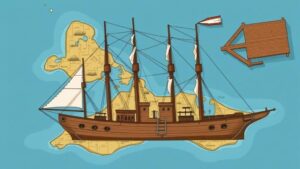Exploring Forgotten Fisheries for Maritime Conservation Artifacts
Exploring Forgotten Fisheries for Maritime Conservation Artifacts
The maritime environment is rich in biodiversity and cultural history, often exhibiting a complex interplay between human activity and natural ecosystems. Fisheries, as both economic and ecological systems, play a crucial role in this dynamic. But, many historic fisheries are now forgotten, presenting a unique opportunity to explore maritime conservation artifacts. This article aims to examine the significance of these forgotten fisheries, their historical context, and how they can contribute to modern conservation efforts.
Historical Context of Fisheries
Fishing has been a fundamental aspect of human livelihood for millennia, contributing not only to sustenance but also to economic development and cultural heritage. According to the Food and Agriculture Organization (FAO), global fish consumption has risen considerably, increasing from 9.9 kg per capita in 1961 to 20.5 kg per capita in 2019. This historical reliance on marine resources has often resulted in overfishing and habitat degradation, particularly in areas that once thrived with productive fisheries.
The decline of various fisheries can often be linked to broader socio-economic changes. For example, the collapse of the northern cod fishery in Newfoundland and Labrador during the 1990s, attributed to overfishing, has left a significant impact on the local economy and culture. This catastrophic event serves as a stark reminder of the fragility of marine ecosystems and the need for sustainable practices.
Importance of Forgotten Fisheries
Forgotten fisheries, often located on coastal regions that have either transformed due to industrial expansion or have been abandoned, hold important insights into past marine resource management. Exploring these areas can reveal a wealth of information about sustainable fishing practices that were employed before the advent of modern fishing technologies.
- Preservation of Traditional Knowledge: Forgotten fisheries often encapsulate indigenous practices and local knowledge systems that prioritized sustainable resource management.
- Identification of Biodiversity Hotspots: Many abandoned fishing sites have allowed ecosystems to recover and can help identify biodiversity hotspots that once thrived.
- Potential for Ecotourism and Education: These sites can also be pivotal in developing ecotourism initiatives, contributing to local economies while simultaneously educating visitors on maritime conservation.
Case Studies of Forgotten Fisheries
Examining specific case studies provides valuable insights into the implications of forgotten fisheries for maritime conservation efforts.
The Baltic Sea Herring Fishery
Historically significant, the herring fishery of the Baltic Sea was once a major contributor to the economies of surrounding countries. A comprehensive study by the Baltic Marine Environment Protection Commission noted that the overexploitation, particularly from the 1950s to the 1990s, led to severe declines. The recent efforts to revitalize this fishery, focusing on sustainable practices and the recovery of fish populations, highlight how understanding past management can inform current conservation strategies.
The Great Lakes Commercial Fishery
Once a booming industry, the commercial fishery in the Great Lakes saw a significant decline due to pollution, habitat loss, and the introduction of invasive species like the zebra mussel. Restoration efforts have focused on understanding historical patterns of fish populations. U.S. Geological Survey emphasizes that by studying these historical fisheries, strategies can be developed to rehabilitate ecosystems, restoring balance to both fish populations and local economies.
Methods for Exploring Forgotten Fisheries
Exploring forgotten fisheries requires a multifaceted approach that integrates historical research, ecological assessments, and community engagement.
- Archaeological Investigations: Field studies can uncover artifacts, fishing gear, and remnants of structures that point to historical fishing methods.
- Historical Documentation: Reviewing archives, such as shipping logs and fishery records, helps piece together the historical significance of these sites.
- Community Involvement: Engaging local communities, particularly indigenous groups, provides invaluable insights into traditional fishing practices and local ecological knowledge.
Challenges and Future Directions
Despite the potential benefits of exploring forgotten fisheries, several challenges remain. These include funding limitations for research, navigating regulatory frameworks, and ensuring stakeholder collaboration. Plus, as climate change continues to alter marine conditions, understanding historical fisheries becomes increasingly urgent.
Future research should aim to integrate modern technologies, such as Geographic Information Systems (GIS) and remote sensing, to better analyze and visualize historical data. Also, promoting partnerships between academic institutions, local governments, and fishing communities can facilitate more comprehensive and sustainable conservation initiatives.
Conclusion
Exploring forgotten fisheries provides significant opportunities for maritime conservation. By examining these historical sites, we can gain valuable insights into sustainable fishing practices, recover lost biodiversity, and develop ecotourism initiatives that benefit local economies. As we move forward, it is crucial to incorporate these findings into current conservation strategies to ensure the longevity of our marine ecosystems.


